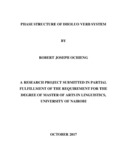| dc.description.abstract | This study is a morphosyntactic analysis of Dholuo verb system in Derivation by Phase Theory. The study sets out to attempt to account for various aspects of the Dholuo verb system in a probe-goal relationship and feature based syntax proposed in Derivation by Phase theory. This theory has reduced major syntactic operations to two: Merge and Agree. The study particularly focuses on the relationship between tense, aspect, negation and the head verb. It also investigates case assignment, passive and antipassive constructions and the benefactive applicative in the Dholuo verb system in the proposed theoretical framework.
The research is qualitative in nature. The data for analysis are sentences in Dholuo collected from primary and secondary sources. The researcher‟s knowledge in language analysis and intuition as a native speaker of Dholuo offered primary data as well. Constant consultation with other native speakers was employed to avoid biases in data analysis.
The research findings show that Derivation by Phase theory cannot fully account for the linguistic variations of the Dholuo verb system without some modifications. In the case of case assignment, the study found that the assignment of nominative case as implied in the adopted theory could not account for such case assignment in Dholuo. This was because there was no tripartite agreement between the tense head, assumed to assign a nominative case in the theory, the subject and verb. As a result, there was difficulty in accounting for the subject pronoun and its case in Dholuo verb system in Derivation by Phase theory. In addition, the findings were that the assumptions held in the methodological analysis of passive and antipassive constructions could not be applied fully in the analysis of the unique behavior of the object in passive and antipassive constructions in Dholuo sentences.
The overall conclusion of this research was that there was need for some significant modifications and changes to the methodological analysis and assumptions held in Derivation by Phase theory so as to fully account for both the agglutinative nature of Dholuo verb system as well as the unique nature of the arguments to the predicate. | en_US |



